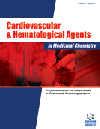- Home
- A-Z Publications
- Cardiovascular & Hematological Agents in Medicinal Chemistry (Formerly Current Medicinal Chemistry - Cardiovascular & Hematological Agents)
- Previous Issues
- Volume 6, Issue 2, 2008
Cardiovascular & Hematological Agents in Medicinal Chemistry (Formerly Current Medicinal Chemistry - Cardiovascular & Hematological Agents) - Volume 6, Issue 2, 2008
Volume 6, Issue 2, 2008
-
-
Non Peptidic Urotensin II Antagonists: Perspectives for a New Class of Drugs
More LessUrotensin II (U-II) is a cyclic peptide isolated from a fish. Subsequently, human U-II and its receptor were identified. In rat thoracic aorta U-II triggers powerful vasoconstrictor activity. However, the constrictor response to U-II appears to be variable and highly dependent on the vascular bed examined. Vasoconstriction is not its only effect; U-II and its receptor have been demonstrated in the central nervous system, wher Read More
-
-
-
Pre-Emptive Conditioning of the Ischemic Heart
More LessAuthors: Joseph M. Vitale, Hongyu Qiu and Christophe DepreIschemic heart disease remains one of the most frequent causes of morbidity and mortality worldwide. Although the prognosis of myocardial ischemia has been dramatically improved by the techniques of early reperfusion, the prevention of irreversible ischemic damage remains a critical aspect of the treatment. An appealing novel therapeutic avenue for the prevention of myocardial ischemia relates to the possibility of a Read More
-
-
-
Drug-Eluting Stents: Present and Future
More LessAuthors: Lakshmana Pendyala, Refat Jabara, Toshiro Shinke, Nicolas Chronos, Keith Robinson, Jinsheng Li and Dongming HouIn-stent restenosis (ISR) caused by neointimal hyperplasia is the major drawback after percutaneous coronary intervention (PCI) for obstructive coronary disease, occurring in up to 40% of lesions. Recently, one of the most intriguing new therapies developed is drug-eluting stents (DES) that target the central phenomenon of cellular proliferation that causes ISR. The benefits of stent-based drug delivery include maximizing th Read More
-
-
-
Pharmacological and Cellular Therapies to Prevent Restenosis after Percutaneous Transluminal Angioplasty and Stenting
More LessAngioplasty and stenting have become routine practice for the treatment of significant obstructive atherosclerotic vascular disease. This method of revascularization has a longer history concerning coronary artery disease but is becoming an increasingly used modality of revascularization in the peripheral circulation. Neointimal formation is the pathological basis for restenosis after revascularization procedures such as angioplast Read More
-
-
-
Pharmacological Approach of No-Reflow Phenomenon Related with Percutaneous Coronary Interventions
More LessAuthors: S. J. Valero, R. Moreno, R. Martin Reyes, A. Sanchez Recalde, G. Galeote, L. Calvo, A. Villate and J. L. Lopez SendonThe no-reflow phenomenon (NRP) is characterized by an inadequate myocardial tissue perfusion in the presence of a patent epicardial coronary artery. It generally occurs after temporary occlusion of the artery causing myocardial ischemia and necrosis that persist after relief of the vessel occlusion, without evidence of epicardial mechanical obstruction. Currently, the main scenario of NRP is the setting of percutaneous cor Read More
-
-
-
Antithrombotic Agents for Acute Coronary Syndromes
More LessCurrent evidence suggests a central role for antithrombotic agents such as unfractionated heparin (UFH) or low-molecular-weight heparin (LMWH) in the management of acute coronary syndromes (ACS). In patients with acute myocardial infarction, several studies have shown that LMWHs may represent an effective alternative to UFH as an adjunct to thrombolytic therapy and are not associated with an increased risk of major bl Read More
-
-
-
Depression and Cardiovascular Disease: Role of Nitric Oxide
More LessBoth depression and cardiovascular disease are major public health problems. Growing evidence shows that depression is a risk factor for the development of coronary artery disease (CAD). However, the exact mechanisms underlying the interplay between depression and CAD remain to be elucidated. Depression adversely affects autonomic and hormonal homeostasis, resulting in metabolic abnormalities, inflammation, i Read More
-
-
-
IL-1 Cytokines in Cardiovascular Disease: Diagnostic, Prognostic and Therapeutic Implications
More LessInterleukins (ILs) are key mediators in the chronic vascular inflammatory response underlying several aspects of cardiovascular disease. Due to their powerful pro-inflammatory potential, and the fact that they are highly expressed by almost all cell types actively implicated in atherosclerosis, members of the IL-1 cytokine family were the first to be investigated in the field of vessel wall inflammation. The IL-1 family is comprise Read More
-
Volumes & issues
-
Volume 23 (2025)
-
Volume 22 (2024)
-
Volume 21 (2023)
-
Volume 20 (2022)
-
Volume 19 (2021)
-
Volume 18 (2020)
-
Volume 2 (2020)
-
Volume 17 (2019)
-
Volume 16 (2018)
-
Volume 15 (2017)
-
Volume 14 (2016)
-
Volume 13 (2015)
-
Volume 12 (2014)
-
Volume 11 (2013)
-
Volume 10 (2012)
-
Volume 9 (2011)
-
Volume 8 (2010)
-
Volume 7 (2009)
-
Volume 6 (2008)
-
Volume 5 (2007)
-
Volume 4 (2006)
Most Read This Month
Article
content/journals/chamc
Journal
10
5
false
en


